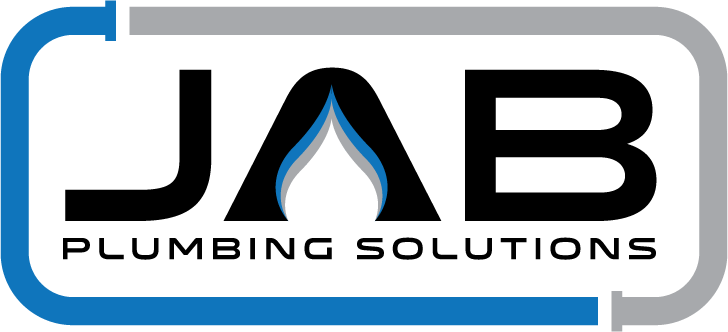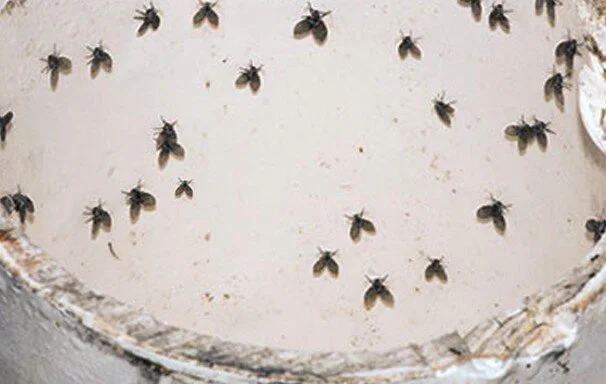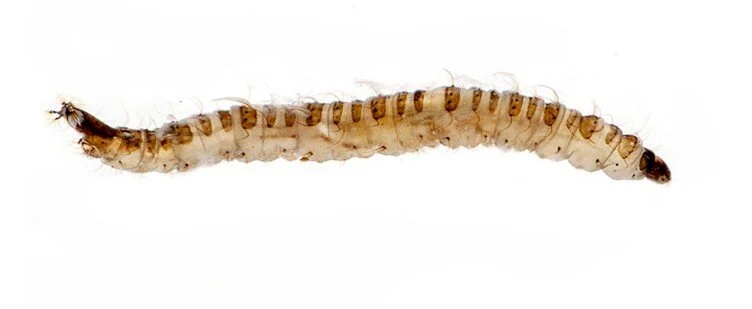drain flies and drain fly larvae
Drain flies are also known as sewer gnats or sewer flies.
Have you noticed little tiny flies in the bathroom? Are there small flies in the toilet? Maybe you were confused as to why there were fruit flies in shower? If you’ve been confronted with small fuzzy flies hanging around the bathroom drains you could be dealing with a drain fly infestation. Also known as sewer flies, these tiny moth-like creatures are attracted to damp areas that contain nutrient-rich organic matter, making drains, sewers and septic tanks ideal breeding grounds.
While drain flies are harmless, they breed in large numbers making them a nuisance in the home. Females can lay between 30 and 100 eggs at one time, and it takes just two days for eggs to hatch into drain worms. In just a few days, the population can start to get out of control.
A drain fly infestation inside a bathroom drain pipe.
Drain flies: how to identify a drain fly infestation
The first step to getting rid of drain flies is correct identification. You need to know exactly what kind of pest you’re dealing with in order to implement a solution that works.
Drain flies are most commonly found in the bathroom, particularly in drains that have stagnant water or grime sitting in the pipes. Therefore, you’ll probably find the small flies in the toilet, sink drain or shower. Drain flies often go hand in hand with blocked drains because water, sewage and other debris is unable to move freely through the pipes. They instead accumulate in the pipeline creating the perfect breeding environment for drain flies.
Drain flies are quite small – around 1.5 mm – 5mm in length and are normally grey or light brown in colour. Their bodies are covered in fine hairs, giving them a fuzzy appearance and they leave behind a powdery substance when they are crushed, similar to moths.
If you see flies matching this description in your kitchen or bathroom don’t automatically assume that you have drain flies. They look very similar to other household pests such as fruit flies, so make sure you check other potential sources such as rotting fruit.
The most effective way to determine if you have drain flies is to place a piece of tape over the drain access point where you’ve noticed the flies. If the drain flies get stuck on the tape as they try to exit the drain, you know you have drain flies.
These flies, also known as moth flies, filter flies, and sewage gnats are larger than fruit flies and more moth-like in appearance.
Getting rid of drain flies and drain fly Larvae
1. Boiling water
Once you know where the drain flies are breeding, keep the drain opening covered with sticky tape or a drain plug at all times. Once or twice daily, boil a pot of water, uncover the drain and pour the boiling water down. Make sure you continue the process for at least a week until all the flies are gone.
While this method should kill the flies and their larvae, it won’t necessarily remove the organic matter in the pipes that attracted them in the first place. This means that a new infestation may occur down the track.
2. Vinegar, baking soda and boiling water
The combination of vinegar, baking soda and boiling water will not only kill the flies, it can also help remove the organic matter from the pipes. Combining bicarb and vinegar creates an acid based reaction, where the two substances fizzle and expand. The pressure this creates within the drainpipe that can work to dislodge minor blockages caused by organic debris.
Fill the kettle and pour boiling water down the drain. Measure out half a cup of bicarb soda and pour it down the sink. Follow up with half a cup of white vinegar. After allowing the bicarb and vinegar to fizz for around five minutes, pour another kettle of boiling water down the drain. Repeat the steps every couple of days until the drain flies are eliminated.
In order to kill drain fly larvae and prevent the drain fly infestation returning you need to remove the organic matter where the flies are breeding.
3. Natural drain cleaners
There are a number of environmentally-friendly drain cleaning products on the market that can be used to resolve a drain fly infestation. We don’t normally recommend these products because they aren’t very effective at clearing tough blocked drains.
However, eco-drain cleaners may remove organic matter from drains such as sewerage, paper, hair, animal fat, grease and food scraps. By removing this organic matter from drain pipes, these products are also removing the food source and breeding sources of the drain flies.
The only problem with eco-drain cleaners is that don’t work on blocked drains caused by non-organic matter such as make-up wipes or sanitary item. Organic matter will continue to get snagged on these other items until the underlying cause of the blockage is addressed.
4. Get your drains cleaned professionally by a blocked drain plumber
The most effective way to eradicate drain flies for good is to get your sewer pipes and drains professional cleaned by a Sydney drainage plumber. Jet blasters, also known as water jetting, has a purpose-built high-pressure pump that blasts away stubborn blockages in the sewer pipes including any sediment. Jet blasting won’t just attack the breeding area of drain flies, it will completely clean the inside of the pipes, flushing away both organic and non-organic matter that has built up over time.










